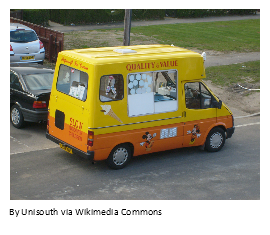 Have you ever noticed how the crowds waiting for commuter trains at Paddington (or doubtless most other big terminus stations) nearly all stay on the concourse until the platform is announced, even though each train usually runs from the same platform every day (so the regular commuters who are the majority all know which it is likely to be)? Consequence – a great crush as everyone rushes at the ticket barriers at once.
Have you ever noticed how the crowds waiting for commuter trains at Paddington (or doubtless most other big terminus stations) nearly all stay on the concourse until the platform is announced, even though each train usually runs from the same platform every day (so the regular commuters who are the majority all know which it is likely to be)? Consequence – a great crush as everyone rushes at the ticket barriers at once.
Beating the crowd
There are always a small number of people who don’t wait. They go calmly through the barrier with no queues, and get seats exactly where they want, beating the crowd instead of risking no seat at all. Maybe once in a blue moon the platform is different and they have to move – but it’s rare. It’s a great illustration of how conformist people (or at least we Brits) tend to be. I would guess less than 5% make the rational risk-reward trade-off and act accordingly, beating the crowd. 95% of us prefer to be part of the herd – but I wonder whether it is the people you would expect? Now there’s an interesting way to separate the sheep from the goats! Given those proportions, it is hardly surprising that very few people embrace change before they have to – even if they would stand to benefit from being early adopters. On the other hand, as change managers we have no need to wait until everything is ready before making announcements, unlike station staff. Early communication leads to more organised loading! Oxford is a city that is full of tourists, and in the UK where there are tourists, there are brown signs to direct them to the attractions. As well as the name of the attraction, a sign often also has what might best be called (by analogy with IT) an icon. The sign in the picture shows the word ‘Sheldonian' and a mask – the icon for a theatre. As you might guess, it directs you to the Sheldonian Theatre. So far so good.
There is just one problem. The theatre in question is not a place where you go to see plays. It is in fact the main ceremonial building of the university, where amongst other things, students are admitted, and all being well, later receive their degrees. I don’t suppose it confuses proud parents attending the ceremony, but I wonder what less well-informed tourists make of it?
Oxford is a city that is full of tourists, and in the UK where there are tourists, there are brown signs to direct them to the attractions. As well as the name of the attraction, a sign often also has what might best be called (by analogy with IT) an icon. The sign in the picture shows the word ‘Sheldonian' and a mask – the icon for a theatre. As you might guess, it directs you to the Sheldonian Theatre. So far so good.
There is just one problem. The theatre in question is not a place where you go to see plays. It is in fact the main ceremonial building of the university, where amongst other things, students are admitted, and all being well, later receive their degrees. I don’t suppose it confuses proud parents attending the ceremony, but I wonder what less well-informed tourists make of it?
Poor branding
I won’t speculate on whether the person who designed the sign realised what they were doing, but it reminded me of an important business truth. Broadly interpreted, what happened here was poor branding – the icon was inconsistent with the meaning, potentially leading to confusion and frustration. The importance of consistency and integrity of messages is universal, whether or not the messages we are giving would conventionally be thought of as branding. When everything we see and hear is consistent, we believe in the authenticity of the message, and that builds trust, be it in a product, an organisation, a person, or a set of signs. When we realise that that consistency is lacking, trust is lost - even if only in the brown signs. Any time you want to build trust, think of yourself as managing your own brand. As change managers, the ability to build trust is one of our most important skills – so we can't afford poor branding. Whatever and however you are communicating (particularly when you are not deliberately communicating at all!), be authentic – then you will also have that essential consistency. Perhaps it does not matter if one set of signs has an odd choice of image, or just how much the signs are trusted. But how many times have you made similar mistakes, which may have had worse consequences?
Review of 11 Rules for Creating Value in the Social Era by Nilofer Merchant
 Perhaps surprisingly, given the title, Nilofer Merchant’s short book is not so much about the ‘how’ of social media, as the paradigm shift it has enabled in the way that most of the world does business.
In the old days, ‘efficiency’ – doing things right – ruled. You made more money by having more efficient processes, and by having the scale to cover your high fixed costs easily. Large dominant players with efficient processes made it almost impossible for small companies to overcome the barriers to entry. In the past those approaches may also have been ‘effective’ – doing the right things – but the context has changed.
In the new world, while scale and efficiency can be good strategies where there are low levels of innovation and change, the inherently cautious response of big, efficient organisations becomes a disadvantage: the ‘right things’ change too fast. High rates of innovation and change have become possible through the power of social media. Merchant says that a new approach is needed, based on embracing what social media enables, characterised by
Perhaps surprisingly, given the title, Nilofer Merchant’s short book is not so much about the ‘how’ of social media, as the paradigm shift it has enabled in the way that most of the world does business.
In the old days, ‘efficiency’ – doing things right – ruled. You made more money by having more efficient processes, and by having the scale to cover your high fixed costs easily. Large dominant players with efficient processes made it almost impossible for small companies to overcome the barriers to entry. In the past those approaches may also have been ‘effective’ – doing the right things – but the context has changed.
In the new world, while scale and efficiency can be good strategies where there are low levels of innovation and change, the inherently cautious response of big, efficient organisations becomes a disadvantage: the ‘right things’ change too fast. High rates of innovation and change have become possible through the power of social media. Merchant says that a new approach is needed, based on embracing what social media enables, characterised by
- Community: A far more flexible way of allocating work;
- Creativity: Allowing co-creation of value with customers;
- Connections: A more open approach than in the past to customer relationships.
 Have you ever been in a situation where it is obvious from the way management is behaving that something is going on, but where no-one will explain? If so, how did you react?
Suppose you were selling a division of a business, what would you tell the division staff about what is happening, and when?
Management’s instinct always seems to be to say nothing until staff can be told everything – which might not be until the deal has already been signed. It is hard to argue against the objection that the deal is market-sensitive information, and that telling them anything would risk breaking Stock Exchange rules. But does that argument really hold water?
In asset sale projects I have run, it has always been essential to include in the project team – and therefore to inform - some people from the division concerned:
• They have to supply much of the due diligence information;
• The bidders want to meet the managers;
• And they want to walk round the assets they are buying.
Of course many people not directly involved notice the unusual visitors, the unusual questions, the unusual gathering of documents. They probably hear of a ‘Project X’. They are not stupid. They realise that something is going on.
Have you ever been in a situation where it is obvious from the way management is behaving that something is going on, but where no-one will explain? If so, how did you react?
Suppose you were selling a division of a business, what would you tell the division staff about what is happening, and when?
Management’s instinct always seems to be to say nothing until staff can be told everything – which might not be until the deal has already been signed. It is hard to argue against the objection that the deal is market-sensitive information, and that telling them anything would risk breaking Stock Exchange rules. But does that argument really hold water?
In asset sale projects I have run, it has always been essential to include in the project team – and therefore to inform - some people from the division concerned:
• They have to supply much of the due diligence information;
• The bidders want to meet the managers;
• And they want to walk round the assets they are buying.
Of course many people not directly involved notice the unusual visitors, the unusual questions, the unusual gathering of documents. They probably hear of a ‘Project X’. They are not stupid. They realise that something is going on.
What will you tell them?
So what happens? The rumour mill goes into overdrive. Speculation in the corridors mounts (and is usually much more threatening than the true story would be). Productivity probably falls – the last thing the company wants just now. The potential for (accidentally) unhelpful comments being made to bidders or to media fishing calls grows – and of course you can’t control what you have not told people. Isn’t it better to treat staff as grownups? What will you tell them? Tell them honestly what you can tell them, and they will understand that there are things you can’t. Tell them the confidentiality rules you need them to follow, and why. Listen to their concerns, and tell them more as and when you can. It may seem like the riskier route, but when I have been open, I have always found that people respect the confidence and cooperate willingly. Not only that, but as a result of feeling better about the relationship with you, they often volunteer useful comments or help. Treating people as grownups means trusting them. If you don’t treat them as grownups, why would you be surprised if they don’t behave that way? Your transition is most likely to be smooth if you keep everyone on board during the process. If you would like to talk about how to do that, contact david@otteryconsulting.co.uk. It’s about 5°C outside, and I’ve just heard the chimes of the ice-cream van. Yes, I know its nearly April, and the daffodils are trying to come out, but who would want to put a coat on and go and shiver in the road for five minutes, just to eat something … very cold?
It’s about 5°C outside, and I’ve just heard the chimes of the ice-cream van. Yes, I know its nearly April, and the daffodils are trying to come out, but who would want to put a coat on and go and shiver in the road for five minutes, just to eat something … very cold?

